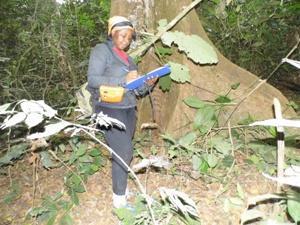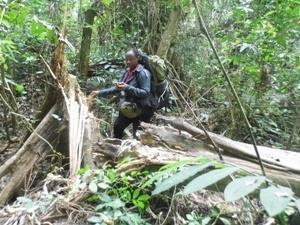Mercy Nambu Diangha
This study aims to intensify roles that habitat quality and humans play in the structuring of mammal community and to specify a monitoring framework for the conservation of Deng Deng National Park.
The Deng Deng National Park was established mainly to protect some viable population of large mammals, including Gorillas, Chimpanzee, Bongos and Buffalos. The park ecosystem is experiencing pressure mostly from illegal logging and some irrational extractions of forest resources particularly bush meat by nearby communities. A portion of this park was earmarked for flooding for the construction of a hydropower plant, therefore threatening the ecosystem within.

Researcher recording observation.
Recent survey in the park revealed the presence of human activities and high densities of large mammals particularly the western lowland gorilla. However the landscape configuration affecting mammal distribution and the extent and intensities of anthropogenic activities and their corresponding effects on mammal community and habitats within the park are less apparent. More research to determine the ecological and geographical relevance of the park and the roles that habitats and humans play in structuring large mammals community is essential to boost the park’s conservation. This project seeks to determine the effects of habitat diversity and the extent of human activities within the Park, and to offer a monitoring framework for the conservation of habitat and mammals in the Deng Deng Park.

Hiking into park.
This project will apply land cover classification and GIS/Remote sensing models in the identification and characterization of the spatial patterns of habitats within the park landscape. It will classify identified habitats based on their suitability for selected mammals species within the park, it will
objectively survey the presence of mammals along transects in identified habitats and will establish the relative importance of threats emerging from anthropogenic factors while indicating their severity, intensities and location across and within the area. Finally it will analyse possible predictions with respect to the diversity and distribution of habitats and mammals, and the intensities and severity of threats within the park boundary. This project will involve relevant stakeholders including local communities.
Outcome from this project including land cover maps and geo-referenced database of suitable habitats of selected mammal species within the park will offer a basis for a scientifically based approach to biological conservation at the park level. Results of the extent and intensities of anthropogenic
influences on habitats will provide opportunities for abating specific threat priorities and for the implementation of cost-effective interventions in the event of limited law enforcement and finances, towards a remarkable conservation of the park. An overview and a thesis with clear policy recommendations will be presented at the end of this project.